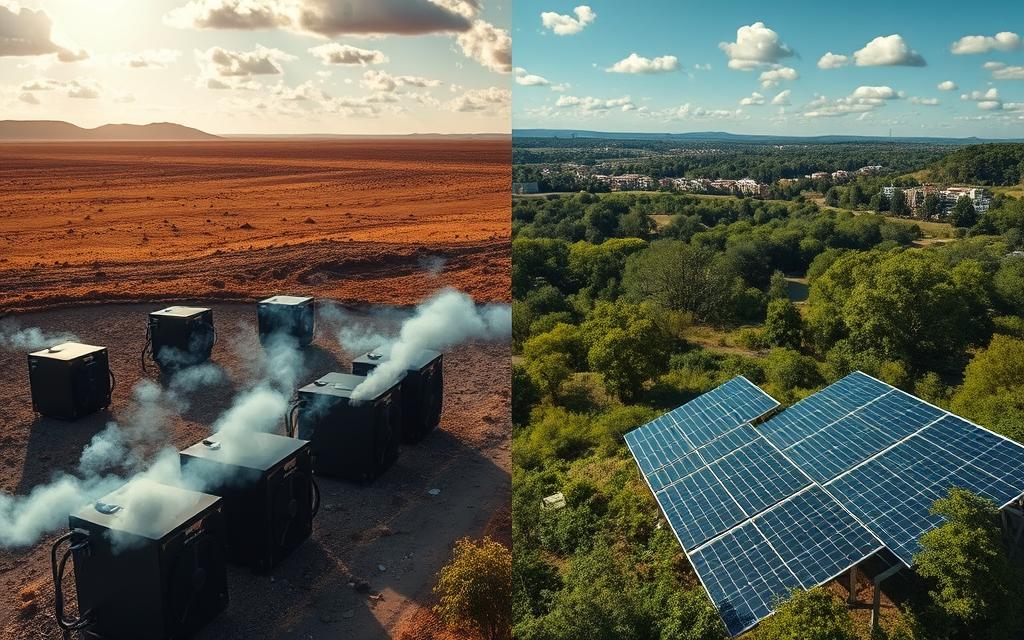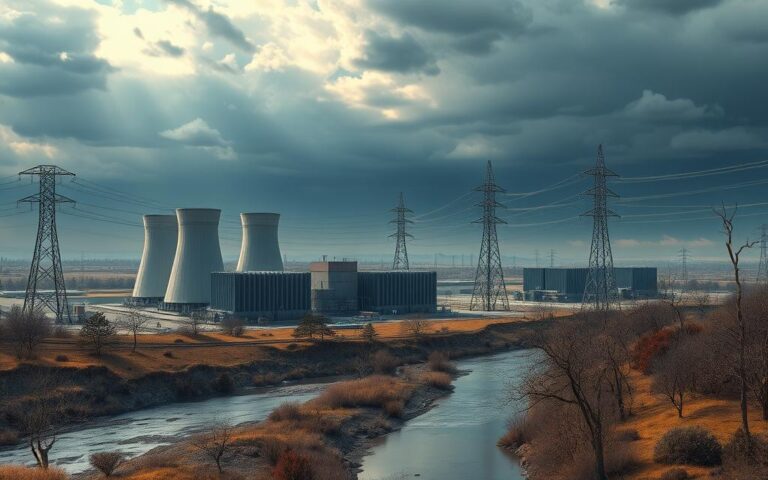Environmental Impact of Cryptocurrency Mining: Challenges and Alternatives
The increase in popularity of digital currencies like Bitcoin has raised concerns. This is due to the environmental impact of mining these currencies. With cryptocurrency prices skyrocketing, there’s been a surge in energy use for mining. The United Nations reports that Bitcoin mining uses about 151 terawatt-hours of electricity yearly. This is 0.59% of the world’s electricity, showing the significant environmental impact.
Moreover, Bitcoin mining emits about 55 million tons of carbon dioxide every year. This is as much as a country like Singapore emits. These emissions highlight the environmental costs of using blockchain technology. In mining Bitcoin, we see the real environmental issues. These include its carbon footprint, e-waste, and reliance on fossil fuels, especially in the United States and China. These two countries are major players in cryptocurrency mining, responsible for over 70% of global activities.
It’s important to look for sustainable alternatives to overcome these challenges. By shifting to proof-of-stake models or using renewable energy, we can make cryptocurrency more eco-friendly. This would reduce the negative impact of traditional mining methods. There’s potential for blockchain technology to be beneficial while also being kind to the earth.
Understanding Cryptocurrency Mining and Its Growth
The world of cryptocurrency mining has changed a lot, thanks to blockchain technology. This tech allows for safe transactions, making digital currencies like Bitcoin more trustworthy. As people and businesses see the value in cryptocurrency, its growth has led to huge changes in mining.
Overview of Cryptocurrency and Blockchain Technology
Cryptocurrency works on a system called blockchain, which records transactions without needing a central authority. This makes things more open and safe, drawing in investors to the world of digital currency. Thanks to quick progress in blockchain tech, the cryptocurrency market is growing fast, with interest in many different crypto-assets, not just Bitcoin.
Rise of Cryptocurrency Prices and Increased Mining Activities
With cryptocurrency prices, especially Bitcoin, skyrocketing, there’s been a big increase in mining. This rush has boosted investor confidence, leading to big investments in mining. How much Bitcoin costs and the energy needed for mining are closely linked, showing how mining statistics depend on market trends.
Statistics on Global Cryptocurrency Mining
The cryptocurrency mining world uses as much electricity as the global banking sector. Bitcoin mining is mainly done in 58 countries, with the US leading by using 37.84% of the energy. Between 2020 and 2021, the electricity Bitcoin used was more than that of countries like Argentina and the Philippines, creating 85.89 metric tons of CO2 equivalent (MTCO2E).
| Year | Electricity Consumption (TWh) | Estimated CO2 Emissions (MTCO2E) |
|---|---|---|
| 2020 | 173.42 | 85.89 |
| 2021 | Comparable to nations | 68.02 |
In 2022, Bitcoin was responsible for 60% to 77% of the world’s crypto-asset electricity use, with 62% coming from fossil fuels. Shockingly, Bitcoin mining created about 30.7 metric kilotons of e-waste each year. This is as much waste as the Netherlands’ IT and telecom industries produce. These mining statistics show both the huge size of Bitcoin’s operations and the growing worry about its effect on the environment.
The Environmental Impact of Cryptocurrency Mining
Cryptocurrency mining affects the environment by increasing carbon footprints, using a lot of energy, and harming nature in other ways. The growth of Bitcoin mining has made many worry about its effects on world carbon emissions. It mainly uses fossil fuels. A detailed look into mining shows many areas that need our attention.
Carbon Footprint and Energy Consumption
In 2022, Bitcoin mining used 95.5 terawatt-hours (TWh) of electricity. This was about 0.4% of the electricity used worldwide. Much of this energy came from burning fossil fuels. In the US, 54% of the miners’ energy came from such sources. This led to about 65 million tonnes of CO2 emissions. It added roughly 0.2% to the world’s total greenhouse gas emissions. These numbers show Bitcoin mining’s big impact on our climate.
Water and Land Footprint of Mining Operations
Bitcoin mining not only uses a lot of electricity but also a lot of water. In 2021, it needed about 1,600 gigalitres of water. That’s enough to fill more than 660,000 Olympic-sized pools. The mining also used over 1,870 square kilometres of land. These figures show why we need sustainable practices in the fast-growing mining field.
Global Mining Practices and Fossil Fuel Dependency
The reliance on fossil fuels in Bitcoin mining is a big environmental worry. Kazakhstan and China are major contributors to mining emissions, with 20% and 13% respectively. The US is also a big player, causing about 46% of the world’s Bitcoin mining emissions. Moving mining to renewable energy is essential to reduce the bad environmental footprint of mining.
The crypto industry faces energy-related challenges. It must use sustainable practices to overcome these. This balance between innovation and responsibility will lead to a greener future.
Challenges Associated with Cryptocurrency Mining
The world of cryptocurrency mining faces big challenges, such as huge energy use and e-waste growth. Mining uses as much energy as some small nations do. For example, Bitcoin mining used more than 75.4 terawatt hours of electricity in 2020. That’s more than the total energy used by countries like Austria and Portugal. This mining needs a lot of computing power to check transactions.
High Energy Use and E-Waste Generation
Newer mining hardware becomes outdated fast. This creates a lot of electronic waste, which is hard to deal with. As tech advances, old devices are quickly left behind, causing a big e-waste problem. Mining is also common in places where power is cheap but comes from non-green sources. Even though there are new methods that might use less energy, most mining still follows the old ways.
Impact on Local Ecosystems and Communities
Mining harms local ecosystems and communities. It uses a lot of fossil fuels, causing pollution and using up resources. This can harm wildlife and land, leading to disputes over water and land use. There’s a push for mining to use renewable energy like solar and wind power to lessen these effects.
Economic Disparities and Regulatory Challenges
The world of cryptocurrency mining is uneven, making it tough to manage. People with more money and tech can gain a lot, leaving smaller miners facing high costs and weak rules. Currently, the rules around cryptocurrency mining don’t do enough to fix these issues. Fighting for better regulations could make mining fairer and more responsible.

Exploring Sustainable Alternatives to Cryptocurrency Mining
The need to find greener methods for cryptocurrency mining is becoming urgent. It’s led to looking for sustainable options. This could greatly change how digital currencies work and help technology be more eco-friendly.
Transitioning to Proof-of-Stake and Other Efficient Models
Switching to proof-of-stake (PoS) from proof-of-work (PoW) is a key move for sustainable cryptocurrency. For example, Ethereum cut its power use by over 99% when it moved to PoS in September 2022. This switch helps save energy and makes the entire crypto world more environmentally sustainable.
Investing in Renewable Energy Solutions
Using renewable energy like solar and wind is crucial for reducing crypto mining’s carbon footprint. Blockstream and Bitfarms show how investing in green energy works. Bitcoin mining’s huge energy demand makes these efforts important.
Case Studies: Successful Implementation of Sustainable Practices
Several companies are adopting eco-friendly actions. Ecoterra and KlimaDao, for instance, reward recycling and promote carbon credits with crypto. These case studies highlight the shift towards greener digital currencies. They show how working together can make a difference.
For more insights into the transition to sustainable cryptocurrency practices, check out this informative resource on sustainable alternatives to Bitcoin mining.
Conclusion
The cryptocurrency industry’s impact on the environment has been a major concern. Mining operations use a lot of electricity, more than some countries. This leads to high carbon emissions and using too many resources.
Industry leaders, regulators, and investors need to work together. They should find greener alternatives to the current ways of mining. Moving to methods like Proof-of-Stake could help reduce the environmental impact.
Investing in renewable energy is also key. It can help make finance more sustainable and meet global green goals. The cryptocurrency world needs to switch to eco-friendly practices.
By adopting innovative and green strategies, the crypto community can help the planet. This shift could show that digital currencies can be good for the environment.
FAQ
What is the environmental impact of cryptocurrency mining?
Cryptocurrency mining greatly affects our environment. It leads to carbon emissions and uses lots of energy and resources. Bitcoin mining, for instance, adds over 85.89 million metric tons of CO2 to the atmosphere each year. This accelerates global warming.
How does Bitcoin mining affect energy consumption?
Bitcoin mining uses a lot of power. Every year, it consumes about 173.42 Terawatt hours of electricity. That’s as much as some whole countries use. This puts a big strain on the world’s resources, especially since much of this energy comes from fossil fuels.
Are there sustainable alternatives to cryptocurrency mining?
Yes, there are greener options available. For instance, using proof-of-stake (PoS) models cuts down energy needs. Also, mining with renewable energy helps lessen the environmental impact.
What are the challenges associated with cryptocurrency mining?
Mining cryptocurrencies comes with big problems. It uses lots of energy, creates a lot of electronic waste, and damages local environments and communities. This happens through pollution and using up natural resources.
How has the rise in cryptocurrency prices influenced mining activities?
As cryptocurrency prices have soared, mining has exploded like a modern-day gold rush. This has led to more investments and mining activities. Energy use has shot up by 140% in some places because of this.
What role do regulators play in sustainable cryptocurrency practices?
Regulators play a key role in making cryptocurrency mining greener. They bring different groups together to push for better technology. This helps make mining more environmentally friendly.
What is proof-of-stake and how does it differ from traditional mining?
Proof-of-stake (PoS) is a method that lets people create and confirm new blocks by staking their coins. It needs much less energy than traditional mining, which involves solving complex calculations.
How do fossil fuels impact the environmental footprint of cryptocurrency mining?
A lot of the power for mining cryptocurrencies comes from fossil fuels. Around 45% is generated from coal and 21% from natural gas. This dependence worsens the environmental impact by contributing to carbon emissions and climate change.















